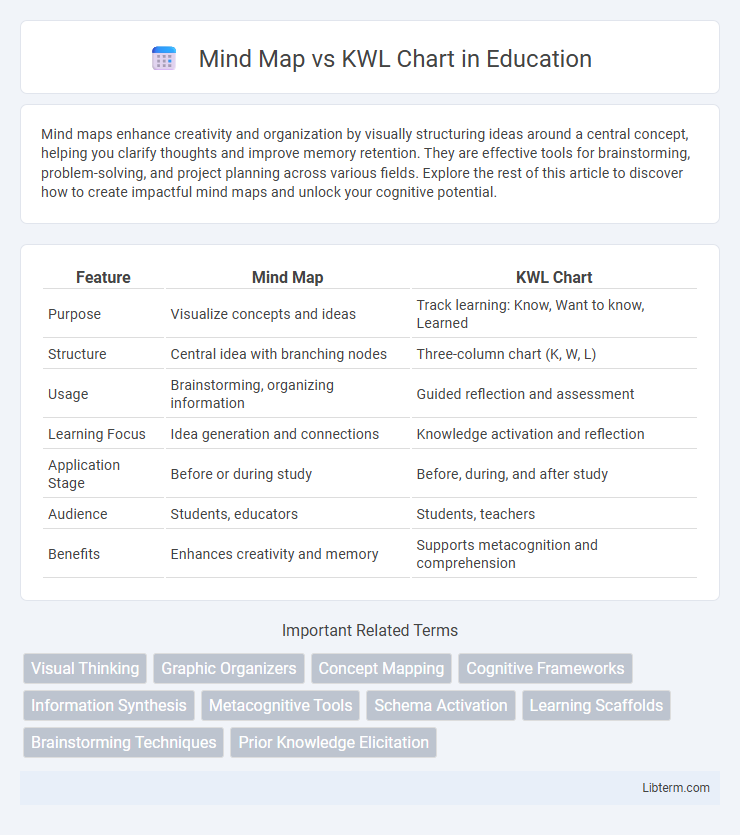Mind maps enhance creativity and organization by visually structuring ideas around a central concept, helping you clarify thoughts and improve memory retention. They are effective tools for brainstorming, problem-solving, and project planning across various fields. Explore the rest of this article to discover how to create impactful mind maps and unlock your cognitive potential.
Table of Comparison
| Feature | Mind Map | KWL Chart |
|---|---|---|
| Purpose | Visualize concepts and ideas | Track learning: Know, Want to know, Learned |
| Structure | Central idea with branching nodes | Three-column chart (K, W, L) |
| Usage | Brainstorming, organizing information | Guided reflection and assessment |
| Learning Focus | Idea generation and connections | Knowledge activation and reflection |
| Application Stage | Before or during study | Before, during, and after study |
| Audience | Students, educators | Students, teachers |
| Benefits | Enhances creativity and memory | Supports metacognition and comprehension |
Introduction to Mind Maps and KWL Charts
Mind Maps are visual tools that organize information hierarchically around a central concept, enhancing memory and creativity by connecting ideas through branches and keywords. KWL Charts structure learning by dividing knowledge into three columns: What you Know, What you Want to know, and What you Learned, promoting active engagement and reflection. Both tools support comprehension but differ in format and application--Mind Maps emphasize idea expansion, while KWL Charts focus on guided inquiry and assessment.
What is a Mind Map?
A mind map is a visual tool used to organize information hierarchically, starting with a central concept and branching out into related ideas or topics. It enhances memory and creativity by using colors, images, and keywords to represent relationships between concepts. Mind maps are widely utilized in brainstorming, note-taking, and problem-solving across educational and professional settings.
What is a KWL Chart?
A KWL Chart is an educational tool that helps students organize information by dividing knowledge into three categories: What they Know, Want to know, and have Learned. This chart promotes active learning and reflection, making it easier to track progress and understanding of a subject. Compared to a Mind Map, which visually represents connections between ideas, a KWL Chart focuses on guiding inquiry and comprehension through structured questioning and answers.
Key Features of Mind Maps
Mind maps feature a hierarchical structure that organizes information visually around a central concept, enhancing memory retention and idea generation. Key elements include branches representing main topics, sub-branches for related details, and the use of colors and images to stimulate cognitive connections. Mind maps facilitate flexible thinking and creativity, making them ideal for brainstorming and problem-solving compared to the linear, question-based format of KWL charts.
Key Features of KWL Charts
KWL charts are structured into three columns labeled Know, Want to Know, and Learned, facilitating organized knowledge tracking. They help activate prior knowledge, set learning objectives, and reflect on acquired information, making them ideal for guided learning and assessment. This format supports critical thinking and comprehension by encouraging learners to engage with content before, during, and after instruction.
Comparing Mind Maps and KWL Charts
Mind Maps visually organize information around a central concept, enhancing creative thinking and idea generation, while KWL Charts structure knowledge into what is Known, Wanted, and Learned, promoting active reading and reflection. Mind Maps are ideal for brainstorming and connecting related ideas, whereas KWL Charts are effective for guiding learning processes and tracking comprehension progress. Both tools support learning but serve different cognitive purposes: Mind Maps emphasize associative thinking, and KWL Charts focus on learning assessment.
When to Use Mind Maps
Mind maps are ideal for brainstorming sessions and organizing complex ideas visually, making connections between concepts easier to see and understand. They work well during the early stages of project planning or studying when capturing free-form ideas and hierarchical structures is essential. Mind maps enhance creativity and memory retention by allowing color-coding, images, and varying text sizes to represent data effectively.
When to Use KWL Charts
KWL charts are most effective in the early stages of learning to activate prior knowledge and set clear learning goals by outlining what students Know, Want to know, and have Learned. They are particularly useful for guiding reading comprehension, research projects, and reflective activities where tracking learning progress is essential. Educators often employ KWL charts to foster student engagement and self-assessment in subjects such as science, social studies, and language arts.
Benefits and Limitations of Each Tool
Mind maps enhance creative thinking and organization by visually connecting ideas, making them ideal for brainstorming and complex problem-solving, but they can become cluttered and overwhelming with excessive information. KWL charts structure learning by dividing content into what is known, wanted, and learned, promoting active reflection and knowledge assessment, yet they may oversimplify complex topics and limit deeper exploration. Choosing between these tools depends on whether the goal is to generate and organize ideas flexibly (Mind Map) or to guide and track learning progress systematically (KWL Chart).
Choosing the Right Tool for Effective Learning
Mind Maps visually organize information through interconnected branches, enhancing creativity and memory retention, making them ideal for brainstorming and complex topic exploration. KWL Charts structure learning by identifying what learners Know, Want to know, and have Learned, promoting active engagement and reflection, best suited for reading comprehension and topic introductions. Selecting between these tools depends on learning objectives: use Mind Maps for idea generation and deeper understanding, while KWL Charts support systematic knowledge tracking and goal-setting.
Mind Map Infographic

 libterm.com
libterm.com